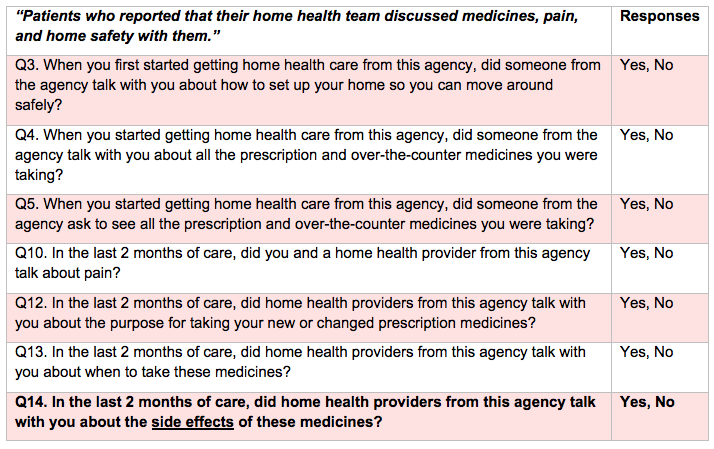
The Home Health Consumer Assessment of Healthcare Providers and Systems (HHCAHPS) patient engagement survey impacts the bottom line of home health agencies substantially, by attracting referral sources and value-based reimbursement. It is imperative for organizations to understand the HHCAHPS survey, and work on improving each measure to maximize long-term growth and sustainability.
Discussing Medication Side Effects– Question 14
Question 14 is the last of seven questions included in the Home Health CAHPS survey Specific Care Issues domain, designed to assess how effectively healthcare providers discuss medicines, pain, and home safety with patients.
Specific Care Issues

This question evaluates the patient’s perception of whether home health providers discussed medication side effects when introducing or changing a medication during the patient’s care. This evaluation builds on the initial medication assessment in questions 4 and 5, gauging patients’ knowledge of their medication and its contributions to achieving treatment goals. Optimizing performance on this question relies on an organization’s ability to ensure any changes made to a patient’s medication regimen are routinely accompanied by thorough discussion of the associated side effects.
Suggestions for Improving Specific Care Issues Related to Medications
- Review patient medications at transitional points of care (e.g., admission, recertification, transfers) and any time a medication is adjusted or introduced to the patient’s treatment plan.
- Discuss the benefits and risks (e.g., side effects and residual symptoms) of each medication so patients have a holistic understanding of their medicines and can make informed healthcare decisions.
- Reassess patient medications on each visit, address any questions or issues that transpired since the last visit, and confirm that medications are still acting as intended.
- Use teaching aids liberally.
Discussing side effects is a critical piece of training patients to manage their medications proficiently. An earlier blog article in this series discussed the Ask 3/Teach 3 Initiative, which aims to align communication around medication delivery by focusing on the following three questions:
- What is the name of the medication?
- Why do I need to take it?
- What are the possible side effects of the medication?
As demonstrated in the Ask 3/Teach 3 Initiative, home health agencies’ policies and procedures should highlight the importance of discussing medication side effects as a routine component when discussing patient medications.
Best practices when discussing medication side effects include teaching patients what to do if symptoms transpire and communicating strategically with patients to promote medication adherence. The table below outlines examples of how providers can integrate these elements into conversations with patients on medicine side effects:
| Best Practices for Discussing Medication Side Effects |
| Tell patients what they should do if they experience side effects.
Healthcare providers should always inform patients of the appropriate steps to take if they start experiencing a new side effect or symptom. “If you experience upper abdominal pain, give me a call as soon as possible.” “If you experience any severe symptoms like shortness of breath or chest pain, go to the emergency room.” |
| Discuss the likelihood and manageability of each side effect.
For some patients, side effects can cause apprehension or fear and decrease the likelihood of successful adherence to the prescribed regimen. To combat fear or apprehension, healthcare providers should remain deliberate when discussing medicine with patients and be clear about the likelihood and manageability of each potential side effect. “This medication is highly effective and safe for most people, but some people report experiencing muscle pain as a side effect. While the chances that you’ll experience this side effect are low, please give me a call if you begin to experience any muscle pain so we can ensure that you remain as comfortable as possible.” |
| Incorporate documentation and educational materials.
Providing documentation or teaching materials on medications enables patients to reference information between appointments and maintain the knowledge necessary for optimal medication management. Details on side effects often accompany prescription medications when dispensed by the patient’s pharmacy, but training materials like the flyer noted below can also be incorporated in agency practices: MedStar Visiting Nurse Association (VNA), an organization dedicated to improving lives through in-home care delivery, provides a Medication Side Effects Flyer outlining the most common side effects associated with medications patients may be taking. Agencies can incorporate a general information resource like this flyer in patient admission materials to deepen patients’ overall understanding of medication side effects and further emphasize their role in achieving treatment goals and ensuring positive patient outcomes. |
Check our blogs for the series on improving your agency’s HHCAHPS scores by systematically reviewing each of the HHCAHPS questions and sharing opportunities for improvement.
